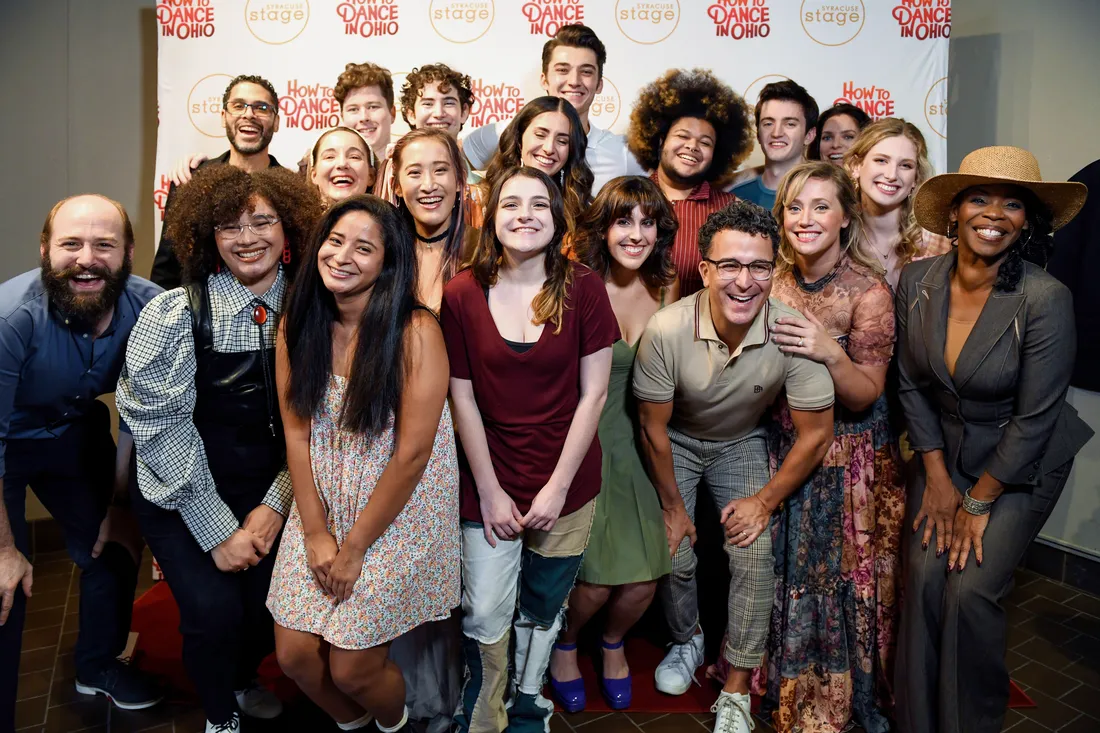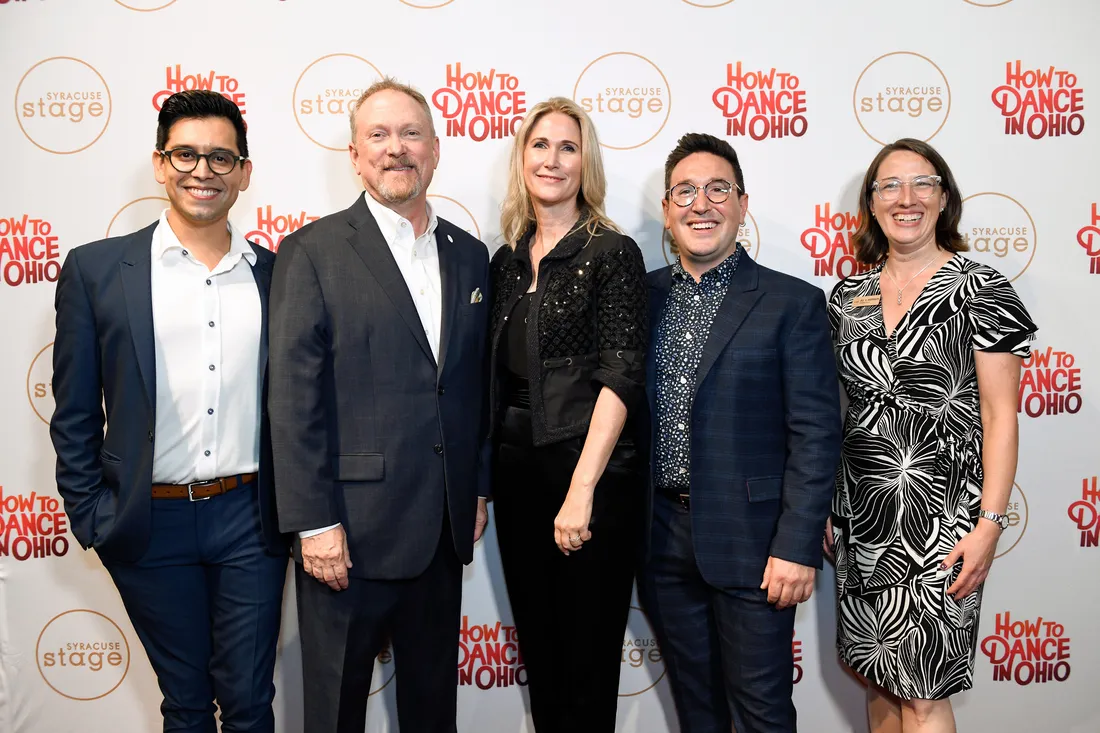
Syracuse Stage kicked off its 2022-23 season with How to Dance in Ohio a musical about a group of young adults with autism organizing a spring formal. (Photo by Curtis Brown)
On the first day of rehearsal, Imri Leshed ’22 knew that How to Dance in Ohio was a different kind of show. Then again, they are a unique performer.
“The director told us not to copy the actors we were covering,” recalls the Syracuse University and College of Visual and Performing Arts (VPA) musical theater graduate, who understudied three roles for Syracuse Stage's 2022-23 season opener. “She wanted us to make the roles our own, to bring our whole selves to the work.”
A self-described queer, neurodivergent artist, Leshed was surprised by the directive—after all, an understudy often imitates characters they’re replacing—but took it to heart. They went on to appear in multiple performances of the world-premiere production, which drew nightly standing ovations and rave reviews. Not even the pandemic, which cut short the show’s sold-out run, could diminish the excitement generated by the cast of actors with and without disabilities.
“I had never worked on a project that was more collaborative and conscientious of everyone’s needs,” says Leshed, who has autism. “It was a great experience for me.”
Syracuse University has helped us recognize our potential—that an equitable, inclusive model of success begins with each of us.
Ben Holtzman ’13, Co-Producer

How to Dance in Ohio provided hands-on training for aspiring actors, like Corinne Ferrer ’23 (bottom row, fifth from left), Imri Leshed ’22 (back row, third from left), Zach Simpson ’24 (back row, second from right) and Elana Babbit ’23 (second from right).
The Need to Connect
How to Dance in Ohio was remarkable for many reasons, not the least of which was its student-friendly ethos. More than a half-dozen drama students comprised the backstage crew, while several more students were cast as understudies. Among the latter were Corinne Ferrer ’23 and Zach Simpson ’24, both acting majors, and Elana Babbit ’23, a musical theater major.
“How to Dance in Ohio did a great job of highlighting underrepresented people,” says Ferrer, a visually impaired daughter of Cuban refugees. “One of my favorite lines was by my character, who said, ‘You make decisions in life without knowing the outcome. That’s a part of growing up.’ It’s timeless, universal advice.”
I grew a lot as an artist, being mentored by these amazing people. More importantly, I learned a lot about teamwork—that it’s not about me or my performance but the strength of the ensemble.
Corinne Ferrer ’23
While understudying can seem like an underappreciated endeavor, it’s a great way for students to gain experience and get discovered. “I grew a lot as an artist, being mentored by these amazing people,” continues Ferrer, noting that about half of the cast had developmental disabilities. “More importantly, I learned a lot about teamwork—that it’s not about me or my performance but the strength of the ensemble.”
Says co-producer Sammy Lopez ’13, “The story is about the universal need to connect. All of us can relate to what it means to put ourselves out there.”

Sammy Lopez ’13 (left) and Ben Holtzman ’13 (right) co-produced the show with Fiona Howe Rudin in association with Syracuse Stage.
Making an Impact Through Inclusive Theater
How to Dance in Ohio is a study in resilience—from the people who have inspired the musical to those who have helped bring it to life. Based on the Peabody Award-winning HBO documentary by the same name, the show follows seven autistic young adults at a counseling center in Columbus, Ohio. Dramatic complications ensue when they are tasked with organizing a spring formal.
“The characters experience a lot of uncertainty, from finding a date, to deciding what to wear, to figuring out how to actually dance,” says Ben Holtzman ’13, who co-produced the show with Lopez and Fiona Howe Rudin in association with Syracuse Stage. “There’s a lot stepping out of your comfort zone, finding your way in the world.”
By having compassion for other people, especially those we don’t know or understand, projects like How to Dance in Ohio can make a positive impact in the world.
Ben Holtzman ’13, Co-Producer
Lopez, Holtzman and Rudin are the brains behind P3, a Tony Award-winning production company committed to artist-driven theater. “By having compassion for other people, especially those we don’t know or understand,” Holtzman says, “projects like How to Dance in Ohio can make a positive impact in the world.”
Credit Tepper Semester faculty member Daisy Prince for introducing Holtzman to her father—Broadway icon Hal Prince. After graduation, Holtzman worked for the legendary producer and director, eventually selling him on How to Dance in Ohio. Hal spent two years developing the concept, before succumbing to a brief illness in 2019 at the age of 91. The Syracuse Stage world premiere was dedicated to his memory.
That Hal and other members of the creative team had family members diagnosed with autism or could identify with people with disabilities, in general, made the storyline relatable. “When we went looking for production partners,” Lopez says, “we knew we needed a theater company that understood what we’re trying to do.”

Sammy Lopez ’13 (far left), Fiona Howe Rudin (center), Ben Holtzman ’13 (second from right) at opening night of How to Dance in Ohio. Also shown are Syracuse Stage Artistic Director Robert Hupp and Managing Director Jill Anderson. (Photo by Brenna Merritt.)
A Homecoming of Sorts
Enter Syracuse Stage—a pioneer of diverse, inclusive theater. Its 2017 production of The Curious Incident of the Dog in the Night-Time drew national attention for casting an autistic actor in the male lead. Lopez and Holtzman still talk about it.
The duo also had warm memories of VPA, where programs like All-Star C.A.S.T. provided opportunities for community actors with disabilities. “All signs pointed toward our alma mater,” says Lopez, adding that Syracuse Stage enables students to earn points toward membership in the Actors’ Equity Association. “We felt like How to Dance in Ohio could be a homecoming of sorts.”
The story is about the universal need to connect. All of us can relate to what it means to put ourselves out there.
Sammy Lopez ’13, Co-Producer
Becky Leifman ’10, executive director of the CO/LAB Theater Group in New York City, was among those hired to help create an inclusive experience. Working with Syracuse Stage’s community outreach and education team, she and other members of CO/LAB led the cast and crew in disability inclusion and anti-ableism training.
Leifman also partnered with ASD creative consultant Ava Xiao-Lin Rigelhaupt, music assistant Nicole D’Angelo (who has autism) and Syracuse Stage’s education department to devise a sensory trigger list, which was posted online, and to write a welcome note for the program booklet.
“Triggers include things and events that cause an uncomfortable or unexpected sensory experience,” says Leifman, referring to sudden or loud sounds as well as sudden light changes. “We prepped everyone on the stage and in the audience, so that they could have a safe and nonjudgmental experience.”
Consequently, performers like Leshed felt at ease. “There’s a camaraderie that comes with being part of something bigger than yourself,” they add. “It was a supportive, family-like atmosphere.”
Pulling Back the Curtain on Theater Production
In addition to developing more socially consciously musicals, Lopez and Holtzman strive to make theater more inclusive. “Democratizing information about the industry is a start,” says Lopez, who teaches at Business of Broadway, a Manhattan-based nonprofit that “pulls back the curtain” on how shows are produced. This fall, he led a Business of Broadway course at Syracuse on theatrical marketing and social media.
“Because so much business knowledge is withheld and perpetuated by a hierarchical system, a lot of early-career producers struggle,” continues Lopez, who, along with Holtzman, plans to workshop How to Dance in Ohio this winter and then find it a home on Broadway, off-Broadway or “somewhere in between.” “About 70% of all theater jobs lack a talent pipeline.”
Adds Holtzman: “Syracuse University has helped us recognize our potential—that an equitable, inclusive model of success begins with each of us.”

